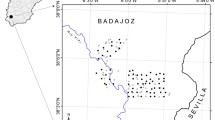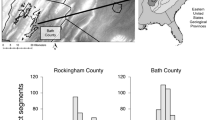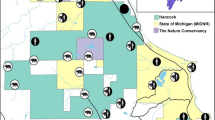Abstract
Terrestrial carnivores typically have large home ranges and exist at low population densities, thus presenting challenges to wildlife researchers. We employed multiple, noninvasive survey methods—scat detection dogs, remote cameras, and hair snares—to collect detection–nondetection data for elusive American black bears (Ursus americanus), fishers (Martes pennanti), and bobcats (Lynx rufus) throughout the rugged Vermont landscape. We analyzed these data using occupancy modeling that explicitly incorporated detectability as well as habitat and landscape variables. For black bears, percentage of forested land within 5 km of survey sites was an important positive predictor of occupancy, and percentage of human developed land within 5 km was a negative predictor. Although the relationship was less clear for bobcats, occupancy appeared positively related to the percentage of both mixed forest and forested wetland habitat within 1 km of survey sites. The relationship between specific covariates and fisher occupancy was unclear, with no specific habitat or landscape variables directly related to occupancy. For all species, we used model averaging to predict occurrence across the study area. Receiver operating characteristic (ROC) analyses of our black bear and fisher models suggested that occupancy modeling efforts with data from noninvasive surveys could be useful for carnivore conservation and management, as they provide insights into habitat use at the regional and landscape scale without requiring capture or direct observation of study species.





Similar content being viewed by others
References
Arthur SM, Krohn WB, Gilbert JR (1989) Habitat use and diet of fishers. J Wildl Manag 53:680–688
Beier P, Penrod KL, Luke C, Spencer WD, Cabañero C (2006) South Coast missing linkages: restoring connectivity to wildlands in the largest metropolitan area in the USA. In: Crooks KR, Sanjayan M (eds) Connectivity conservation. Cambridge University Press, Cambridge, pp 555–586
Betts MG, Ganio LM, Huso MMP, Som NA, Huettmann F, Bowman J, Wintle BA (2009) Comment on ‘‘Methods to account for spatial autocorrelation in the analysis of species distributional data: a review’’. Ecography 32:374–378
Brody AJ, Pelton MR (1989) Effects of roads on black bear movements in western North Carolina. Wildl Soc B 17:5–10
Burnham KP, Anderson DR (2002) Model selection and multimodel inference: a practical information-theoretic approach. Springer-Verlag, New York
Campbell LA (2004) Distribution and habitat associations of mammalian carnivores. Dissertation, University of California, Davis
Cooch E, White GC (2005) Program MARK: a gentle introduction. http://www.phidot.org/software/mark/docs/book. Accessed 15 Aug 2005
Crooks KR, Soulé ME (1999) Mesopredator release and avifaunal extinctions in a fragmented system. Nature 400:563–566
Darrah AJ, Krementz DG (2009) Distribution and habitat use of king rails in the Illinois and Upper Mississippi River Valleys. J Wildl Manag 73:1380–1386
Eng J (2005) ROC analysis: web-based calculator for ROC curves. Johns Hopkins University, Baltimore. http://www.jrocfit.org. Accessed 3 Jan 2010
Fielding AH, Bell JF (1997) A review of methods for the assessment of prediction errors in conservation presence/absence models. Environ Conserv 24:38–49
Garant Y, Crête M (1997) Fisher, Martes pennanti, home range characteristics in a high density untrapped population in southern Québec. Can Field Nat 111:359–364
Ginsberg JR (2001) Setting priorities for carnivore conservation: what makes carnivores different? In: Gittleman JL, Funk SM, Macdonald D, Wayne RK (eds) Carnivore conservation. Cambridge University Press, Cambridge, pp 498–523
Guisan A, Zimmermann NE (2000) Predictive habitat distribution models in ecology. Ecol Model 135:147–186
Hall ER (1981) The mammals of North America. Wiley, New York
Hammond F (2002) The effects of resort and residential development on black bears in Vermont Stratton Mountain Black Bear study. Vermont Agency of Natural Resources, Department of Fish and Wildlife, Waterbury
Kamler JF, Gipson PS (2000) Home range, habitat selection, and survival of Bobcats, Lynx rufus, in a prairie ecosystem in Kansas. Can Field Nat 114:388–394
Kroll AJ, Duke SD, Runde DE, Arnett EB, Austin KA (2006) Modeling habitat occupancy of orange-crowned warblers in managed forests of Oregon and Washington, USA. J Wildl Manag 71:1089–1097
Litvaitis JA, Sherburne JA, Bissonette JA (1986) Bobcat habitat use and home range size in relation to prey density. J Wildl Manag 50:110–117
Long RA, Donovan TM, MacKay P, Zielinski WJ, Buzas JS (2007a) Effectiveness of scat detection dogs for detecting forest carnivores. J Wildl Manag 71:2007–2017
Long RA, Donovan TM, MacKay P, Zielinski WJ, Buzas JS (2007b) Comparing scat detection dogs, cameras, and hair snares for surveying carnivores. J Wildl Manag 71:2018–2025
Long RA, MacKay P, Zielinski WJ, Ray JC (eds) (2008) Noninvasive survey methods for carnivores. Island Press, Washington
Lovallo MJ, Anderson EM (1996a) Bobcat (Lynx rufus) home range size and habitat use in northwest Wisconsin. Am Midl Nat 135:241–252
Lovallo MJ, Anderson EM (1996b) Bobcat movements and home ranges relative to roads in Wisconsin. Wildl Soc B 24:71–76
MacKenzie DI, Bailey LL (2004) Assessing the fit of site-occupancy models. J Agric Biol Environ Stat 9:300–318
MacKenzie DI, Royle JA (2005) Designing occupancy studies: general advice and allocating survey effort. J Appl Ecol 42:1105–1114
MacKenzie DI, Nichols JD, Lachman GB, Droege S, Royle JA, Langtimm CA (2002) Estimating site occupancy rates when detection probabilities are less than one. Ecology 83:2248–2255
MacKenzie DI, Nichols JD, Royle JA, Pollock KH, Bailey LL, Hines JE (2006) Occupancy estimation and modeling: inferring patterns and dynamics of species occurrence. Academic Press, Burlington
Mitchell MS, Zimmerman JW, Powell RA (2002) Test of a habitat suitability index for black bears in the southern Appalachians. Wildl Soc B 30:794–808
Nichols JD, Bailey LL, O’Connell AF Jr, Talancy NW, Campbell Grant EH, Gilbert AT, Annand EM, Husband TP, Hines JE (2008) Multi-scale occupancy estimation and modelling using multiple detection methods. J Appl Ecol 45:1321–1329
Pearce J, Ferrier S (2000) Evaluation the predictive performance of habitat models developed using logistic regression. Ecol Model 133:225–245
Powell RA (1994) Effects of scale on habitat selection and foraging behavior of fishers in winter. J Mammal 75:349–356
Rogers LL (1987) Effects of food supply and kinship on social behavior, movements, and population growth of black bears in northern Minnesota. Wildl Monogr 97:1–72
Samson C, Huot J (2002) Spatial and temporal interactions between female American black bears in mixed forests of eastern Canada. Can J Zool 79:633–641
Terborgh J, Estes JA, Paquet P, Ralls K, Boyd-Heger D, Miller BJ, Noss RF (1999) The role of top carnivores in regulating terrestrial ecosystems. In: Soulé ME, Terborgh J (eds) Continental conservation: scientific foundations of regional reserve networks. Island Press, Washington, pp 39–64
Theobald DM, Hobbs NT, Bearly T, Zack JA, Shenk T, Riebsame WE (2000) Incorporating biological information in local land-use decision making: designing a system for conservation planning. Landscape Ecol 15:35–45
Thompson WL (2004) Sampling rare or elusive species: concepts, designs and techniques for estimating population parameters. Island Press, Washington
Thompson EH, Sorenson ER (2000) Wetland, woodland, wildland: a guide to the natural communities of Vermont. The Nature Conservancy and the Vermont Department of Fish and Wildlife, Hanover
Tyre AJ, Tenhumberg B, Field SA, Niejalke D, Parris K, Possingham HP (2003) Improving precision and reducing bias in biological surveys: estimating false-negative error rates. Ecol Appl 13:1790–1801
U.S. Census Bureau (2005) County population data. http://www.census.gov/popest/counties/. Accessed 5 Aug 2005
White GC, Burnham KP (1999) Program MARK: survival estimation from populations of marked animals. Bird Study 46:120–138
Woodroffe R (2001) Strategies for carnivore conservation: lessons from contemporary extinctions. In: Gittleman JL, Funk SM, Macdonald D, Wayne RK (eds) Carnivore conservation. Cambridge University Press, Cambridge, pp 61–92
Yates MD, Muzika RM (2006) Effect of forest structure and fragmentation on site occupancy of bat species in Missouri Ozark Forests. J Wildl Manag 70:1238–1248
Acknowledgments
We thank B. Davenport, D. MacKenzie, B. Mitchell, D. Paetkau, A. Royle, S. Wasser, S. Weigley, J. Weldon, and various field personnel and scat detection dogs for their contributions to this project. The Vermont Cooperative Fish and Wildlife Research Unit is jointly sponsored by the U.S. Geological Survey, the Vermont Fish and Wildlife Department, the University of Vermont, and the Wildlife Management Institute. Funding for this project was provided by the Vermont Department of Fish and Wildlife, the Northeastern States’ Research Cooperative, the Jon C. and Katherine L. Harvey Charitable Foundation, the Southern Lake Champlain Valley Office of the Nature Conservancy, Sweet Water Trust, the USDA Forest Service, and the U.S. Geological Survey. Finally, we thank Robert L. Schooley and two reviewers for their valuable comments on this manuscript. Mention of services used in this research does not confer endorsement by the U.S. federal government.
Author information
Authors and Affiliations
Corresponding author
Rights and permissions
About this article
Cite this article
Long, R.A., Donovan, T.M., MacKay, P. et al. Predicting carnivore occurrence with noninvasive surveys and occupancy modeling. Landscape Ecol 26, 327–340 (2011). https://doi.org/10.1007/s10980-010-9547-1
Received:
Accepted:
Published:
Issue Date:
DOI: https://doi.org/10.1007/s10980-010-9547-1




